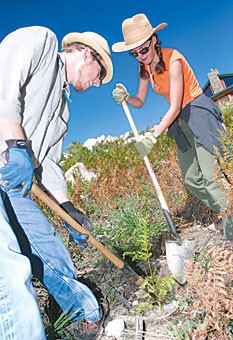Students traveled to Mount Lemmon on Saturday to revegetate areas destroyed by the 2003 Aspen Fire.
Led by Carol Bender, director of the Undergraduate Biology Research Program, the group set out Saturday morning to plant 400 two-year-old ponderosa pine seedlings in Yuma Bowl near Summerhaven on Mount Lemmon.
“”Only one in four seedlings is expected to survive,”” Bender said.
Bender said although it was a demoralizing figure, there would still be 100 more trees on Mount Lemmon than there were before.
Javier Diez Palomar, a Fulbright scholar from Spain, said he received an e-mail invitation from Bender to join the group and jumped at the opportunity.
“”We have a chance to do something good for the planet,”” said Palomar.
In the summer of 2003, the month-long Aspen Fire burned more than 84,000 acres on the Santa Catalina Mountains north of Tucson, according to The Associated Press.
The fire destroyed hundreds of acres of mature conifer forest.
Upon arriving at Yuma Bowl, Bender gave the group a brief demonstration on how to plant the seedlings. Then the group set out with shovels borrowed from the local fire department and a pick-axe to plant the remaining 399 seedlings.
The rocky terrain was tough to dig through, and the group had only one pick-axe to share among them.
The grey logs of burnt trees littered the area where the group was planting the seedlings.
“”At least the old trees will make good mulch for the new trees,”” said Jenny Barker, an ecology and evolutionary biology senior.
Bender also serves on the Trees for Mount Lemmon board of advisers, a nonprofit organization helping the community recover from the 2003 Aspen Fire.
“”The group formed because we were afraid that people were going to plant invasive species,”” said Bender. “”It’s a really fragile ecosystem.””
Cheatgrass and red brome are among the invasive species, and both increase the fire regimes. Bigleaf periwinkle, also an invasive species, spreads aggressively and overtakes other plants, according to an educational flyer put out by Trees for Mount Lemmon.
In order to retain vegetation indigenous to the area, the U.S. Forest Service helped identify and collect pine cones that would be most viable to the area, said Trees for Mount Lemmon Co-Chair John Jones.
The cones are then sent to Flagstaff where they are grown in greenhouses at the Northern Arizona University, said Jones.
Since the destruction of many cabins in Summerhaven, Pima County voters approved a plan to build the Mount Lemmon Community Center in the 2004 bond election, said Jones.
The American Institute of Architecture, the American Planning Association and the UA School of Architecture and Planning oversaw the community’s reconstruction, said Jones.
Construction has already begun on the center and although the project currently lacks $500,000 to complete, Jones said that the center should be finished by the end of summer.
Jones said he believes the project will receive the additional funding because the center will be open to the public and will also provide UA students with a research hub.
Jones went to Washington D.C., Wednesday, to receive the Chief’s Partnership award from the U.S. Forest Service on behalf of Trees for Mount Lemmon.
“”On the plaque, it says; ‘For healing the forest and for healing the community,'”” said Jones.
Barker said on one of her previous UBRP trips, she went with a dendrochronologist, a scientist who studies the annual rings of trees and determines the dates and chronological order of past events, and artist Kate Hodges to learn about how the trees were recovering.
Hodges is the artist behind the carvings on two 30-foot-tall trees from the mountain that now stand across from the Park Student Union.









